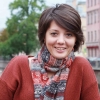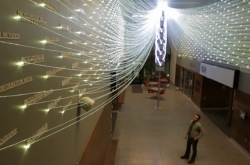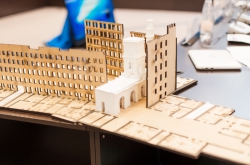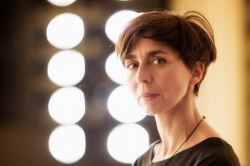PLDC (Professional Lighting Design Convention) is a biennial gathering of specialists in the global market of lighting design. Lighting designers, architects, researchers, representatives of universities and the industry use PLDC as a platform for meetings where they learn about the latest inventions in the field of lighting design and discuss its future; as of now, more than 6,000 professionals of this field have become the event’s participants. The last conference, held in Rome in 2015, gathered representatives from 25 associations, 38 universities and institutes, and 66 partners from the lighting design industry.
At each conference, the organizers announce winners of the PLDR (Professional Lighting Design Recognition) award, which aims to encourage the best experts and name the best practices and educational programs that contributed to the field’s development. According to the organizers, candidates are selected by a special jury comprised of experienced professionals from the international lighting design community.
The awards have eight categories: Best Newcomer, Best Partner in the Industry, Research, Education, and others. This year, ITMO’s Higher School of Lighting Design became the only Russian participant to enter the short-list of the Education category. PLDR’s jury included it into the top-5 of best schools and representatives of the industry along with Aalborg University, Denmark, as well as such renowned professionals in the field of lighting design as Berry van Egten from the Netherlands, Karolina M. Zielinska-Dabkowska from Poland and Stuart Green from Great Britain. The reason for ITMO’s inclusion was the “pioneering work conducted by the university in the field of lighting design”. The winner will be announced at the PLDC-2017 conference in Paris.
This year, no classical Lighting Design schools were nominated for the award; among the candidates are new and innovative educational programs: the Lighting Design Master’s program at Aalborg University has existed for some 3 years, and ITMO University’s Higher School of Lighting Design, or CLD ITMO University, has only been around for some two years.
 Opening of the Year of Light in St. Petersburg
Opening of the Year of Light in St. Petersburg
“Established schools focus more on the classical approaches to lighting design that is about the synergy of architecture and design, while the new schools aim to solve the more comprehensive questions that have to do with the progress of technologies, as well as interaction between information and people. They work in such relevant and promising fields as VR, Big Data, and urban informatics, and develop their innovative educational programs with regard to the different problems of the modern person and his future,” shares Natalya Bystryantseva, Head of Higher School of Lighting Design, the RULD artistic group of lighting designers and ITMO’s Art & Science cluster.
 Natalya Bystryantseva
Natalya Bystryantseva
In 2015, the year of its founding, CLD conducted the first festival of light culture, LumiFest, where ITMO UNiversity students showed their light installations; at the same time, CLS staff organized the second Lighting Design conference, which has become an internationally recognized event.
Art & Science cluster
One of the most important stages in the Higher School of Lighting Design’s activity was the creation of ITMO’s Art & Science cluster. The cluster is an association of scientists and artists, philosophers and business representatives, engineers and sociologists who collaborate on identifying the problems related to humanizing the environment and solving these new challenges. One of the cluster’s key tasks is the creation of professional interdisciplinary teams for project work on particular tasks and the commercialization of promising inventions using the university’s resources.
The cluster’s strategy was developed with regard to the leading trends, which is why its work is focused on “humanizing” the latest achievements in science and technology and making them a part of our environment to accelerate their adoption.
 Lectures as part of ITMO-State Hermitage collaboration
Lectures as part of ITMO-State Hermitage collaboration
By the end of 2016, Art & Science cluster also launched a collaborative project with the State Hermitage museum - Art & Science: Science, Art, Museum, aimed at elaborating on the interaction of art and science, as well as different philosophical problems that emerge from it. Both Russian and international lecturers took part in this project, which helped build a dialog between artists, scientists and engineers as well as define the direction in which the cluster will develop on the international level.
“In our opinion, working with Art & Science projects was a very important stage. It allowed us to look ahead and foresee the development tendencies for not just five, but some twenty years ahead. After we’ve plunged into this field, we made many changes to our educational program. During the work on this project we’ve succeeded in defining the problems related to information quality and understanding the challenges we were about to face in the future. So, we began to organize our work in such a way that our students get all the instruments that will help them in their future practice. What is more, Art & Science showed the world that we don’t just stew in our own juice and aim to solve the market’s current problems. It showed that we focus on global challenges and structure our educational process according to the tendencies that will be of priority in ten and more years,” comments Natalya Bystryantseva.
Working with major projects and international conferences gives the opportunity to work with both the academic community and representatives of the industry. According to Natalya Bystryantseva, if even a year ago neither companies nor the public paid much attention to the problems of light culture, now these subjects are widely discussed by the media, and the industry is ready to apply the new inventions to practice.
A complex development program for St. Petersburg
 Lumifest
Lumifest
A good example of such collaboration with the industry is the joint project of the Higher School of Lighting Design and St. Petersburg state unitary enterprise Lensvet on creating a complex development program for St. Petersburg. This is Russia’s first citywide project that will involve Big Data collection, analysis and structure of the lighting environment, as well as the prediction of its development that would account for an increase in the citizens’ quality of life and the future prospects for growth of the city’s energy sector.
The project’s first stage that ended this spring involved the creation of a model of the city’s lighting environment’s development. The model was based on relevant data from Lensvet and complex analytical research conducted by specialists from ITMO University’s Lighting Design for an Urban Environment International Laboratory. Its authors focused on the problems of energy efficiency, lighting technology, comfort, safety, functionality, pedestrian and transport traffic, social mobility, and the city’s districts’ attractiveness.
The results will serve as groundwork for shaping propositions on making amendments to the existing reference documents that regulate the outdoor lighting system; what is more, the project’s authors have to conduct the final test-runs of algorithms and mathematical models of decision support software for creating targeted lighting environment development programs. The main purpose of such instruments is to help prepare for the rapid and complex analysis of the existing lighting environment, which, in turn, will help optimize the expenditure of budgetary funds. The work on this part of the project is to be finished by September, and used for developing targeted programs of St. Petersburg’s lighting in 2018-2030 with an outlook for 2050.
Not only staff members of the Higher School of Lighting Design took part in the research: its students contributed as well. According to Associate Professor Nikolai Matveev, head of Art & Science’s art residence, the educational process at the school is project-based, so all of the School’s research is part of it.
 Nikolai Matveev
Nikolai Matveev
“All of our units - the Lighting Design for an Urban Environment International Laboratory, the department itself, the students - take part in each of the many projects conducted by the school. And all of them develop along with the project. The results provide great feedback, help understand the effective ways to organizing the educational process and act as a starting point for launching new research. The problems we face during one project prompt us to continue the research and start new lesser projects aimed at solving them,” shares Nikolai Matveev.
Experimental projects: “smart” textile and development of environments for children
The school’s students work on their own projects, as well; for that purpose, there’s the new Student Laboratory experimental division. At this year’s Fashion Futurum international conference, Master’s students Valeria Mikoluk and Roman Antonov, in collaboration with Ekaterina Kuklina, an independent designer, presented their inventions: a smart “chameleon” jacket, jewelry with dynamic lighting and a smart backpack. There are even more non-standard methods for improving the quality of lighting and environment currently in development at the laboratory: interactive parking for bicycles, navigation using mirrors and many more.
As of now, the school’s staff and students have launched a new experimental project that concerns the development of environments for children. First, the researchers decided to define the main problems related to modern children’s activity. After conducting a complex research that involved working with children of different age, the project’s authors learned that they almost forgot how to play with each other. So, they’ve decided to create an environment where children would play and communicate by using lighting and interactive technologies.

“The industry develops in a person-focused manner: each child has a smartphone, but he plays by himself, without communicating with his peers. Yet, to learn communication skills, he has to use them since childhood. As of now, we’re working on creating an environment where children will play with each other using light. Traditional games can be greatly improved if we add more interaction, notes Ilya Smilga, Head of CLD’s Project Laboratory. We already have several sites in mind, for instance, the area at the Bryantsev Youth Theatre; several museums, including the State Hermitage, are also ready to collaborate, so we’ll be developing simulators, both gaming and educational, for them. This is a major theme that is yet to be developed, so we find our project most promising.”
Further development: international cooperation and new approaches to education
Specialists of the Higher School of Lighting Design continue to develop new educational programs and models of the educational process. Last year, they’ve introduced instruments for design analysis that allow them to reconsider the traditional approach to working on a project. This year, they’ve decided to focus on the matter of systemic design, the fundamentals of which will be included in the curricula, as well.
 Students of the Higher School of Lighting Design. Credit: social networks
Students of the Higher School of Lighting Design. Credit: social networks
“Our students work in a project format; while working on a project, they study different instruments of analysis: that can be the analysis of perception, analysis of processes, communications between people, social networks, just anything. By using different instruments of photofixation when working with urban informatics, for instance, they learn to better analyse certain processes and set the right priorities for solving particular tasks, explains Natalya Bystryantseva. Last year, we introduced design analysis into the curricula, which brought great results. This year, we’ll be introducing systemic design, so as to further expand our field of research.”
Among the school’s other plans is to start working with international students, as well. Recently, its delegation visited the Aalborg University, with which the School plans to start new collaborations, including the launch of a joint educational program. The Art & Science cluster’s projects are to develop as well - their results will be introduced into the educational process; what’s more, the new Art & Science Master’s program will be soon launched at ITMO University.






